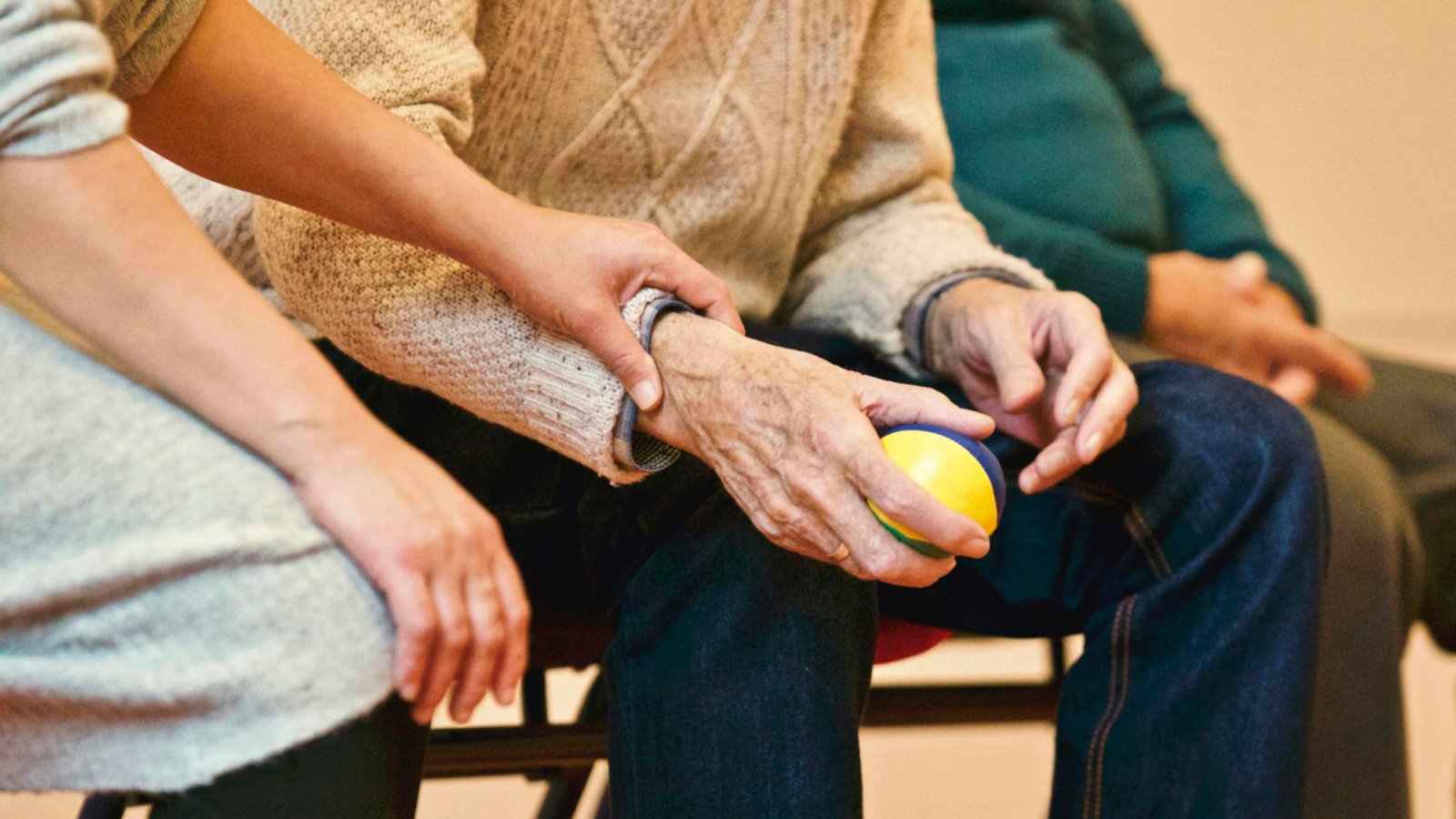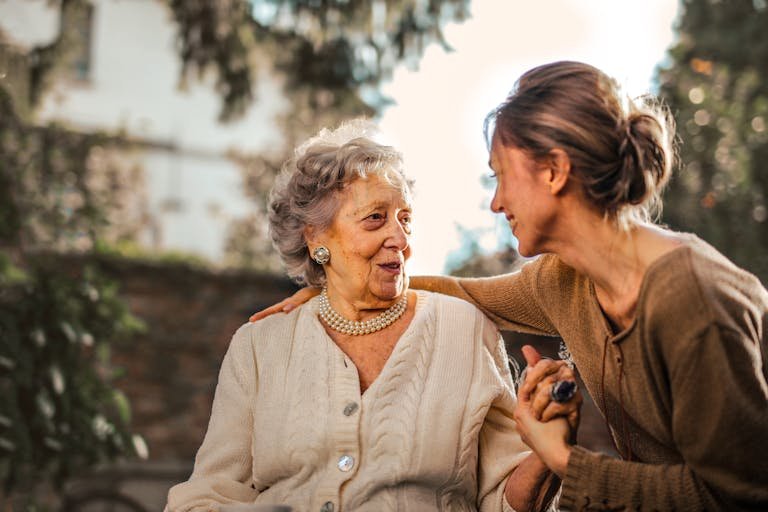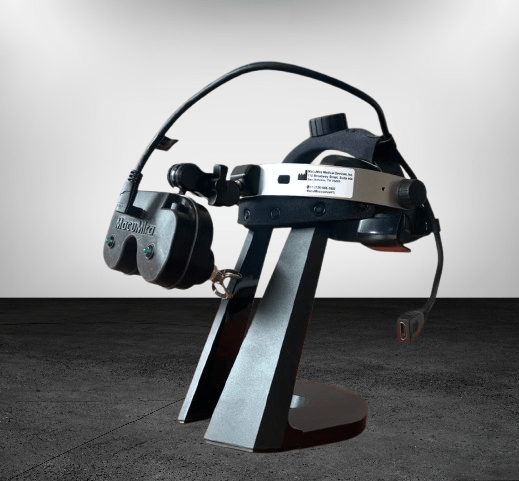A guide for people with vision impairment or blindness
A guide for people with vision impairment or blindness |
Use this table of contents to navigate directly to the section you want to read
What is Low Vision
People with vision impairment or blindness experience many challneges in their day to day livinig activities. As we age, some of us notice a decline in our vision, which is often manageable with glasses if the cause is a Refractive error in Cornea or Presbyopia. However, some individuals experience “low vision,” a significant vision impairment that cannot be corrected with glasses, surgery, or other medical treatments.
This condition is usually caused by eye diseases such as Glaucoma, Macular Degeneration, Diabetic Retinopathy, cataracts and etc,.
Another cause of low vision could be Amblyopia in early ages or even infants, often due to uncorrected refractive errors or congenital cataracts. It is also important to note that vision impairment can result from brain injuries, such as traumatic brain injury (TBI), Cerebral Palsy (CP), Cortical Visual Impairment (CVI), stroke, and other neurological conditions.
There are resources and help for people with vision impairment and blindness in Canada, such as CNIB and VLRC, as well as in the USA and other countries around the world, which will be introduced later in this post.
Before getting to resources, let’s discuss what actually is challenging or causing disabling condition due to their impairment. note that disability is a result of poor condition for a specific impairment. Many facilities, support systems, and societal structures are primarily designed for sighted individuals. However, various environmental factors, including support from family and friends, technology, transportation, and even the home environment, can be modified to be more accessible for people with vision impairment or blindness who are seeking support, assistance, and aids.

Everyday Challenges
Living with low vision presents unique challenges in daily life. Tasks that once seemed simple, such as reading text on medicine bottles, appliances, or utility bills, can become daunting.
Recognizing familiar faces or discerning the edges of steps may also become difficult. Low vision increases the risk of falls, posing a threat to independent living. Everyday objects like low furniture, footstools, or raised surfaces such as doorsills can easily become tripping hazards.
The challenges experienced by people living with vision impairment can be categorized into two types: Activities of Daily Living (ADL) and Instrumental Activities of Daily Living (IADL).
In addition to these practical difficulties, individuals with low vision may experience emotional and psychological challenges. The loss of vision can lead to feelings of frustration, depression, and isolation. It is essential to address these emotional aspects alongside the physical limitations to ensure a holistic approach to managing low vision.
Activities of Daily Living (ADL)
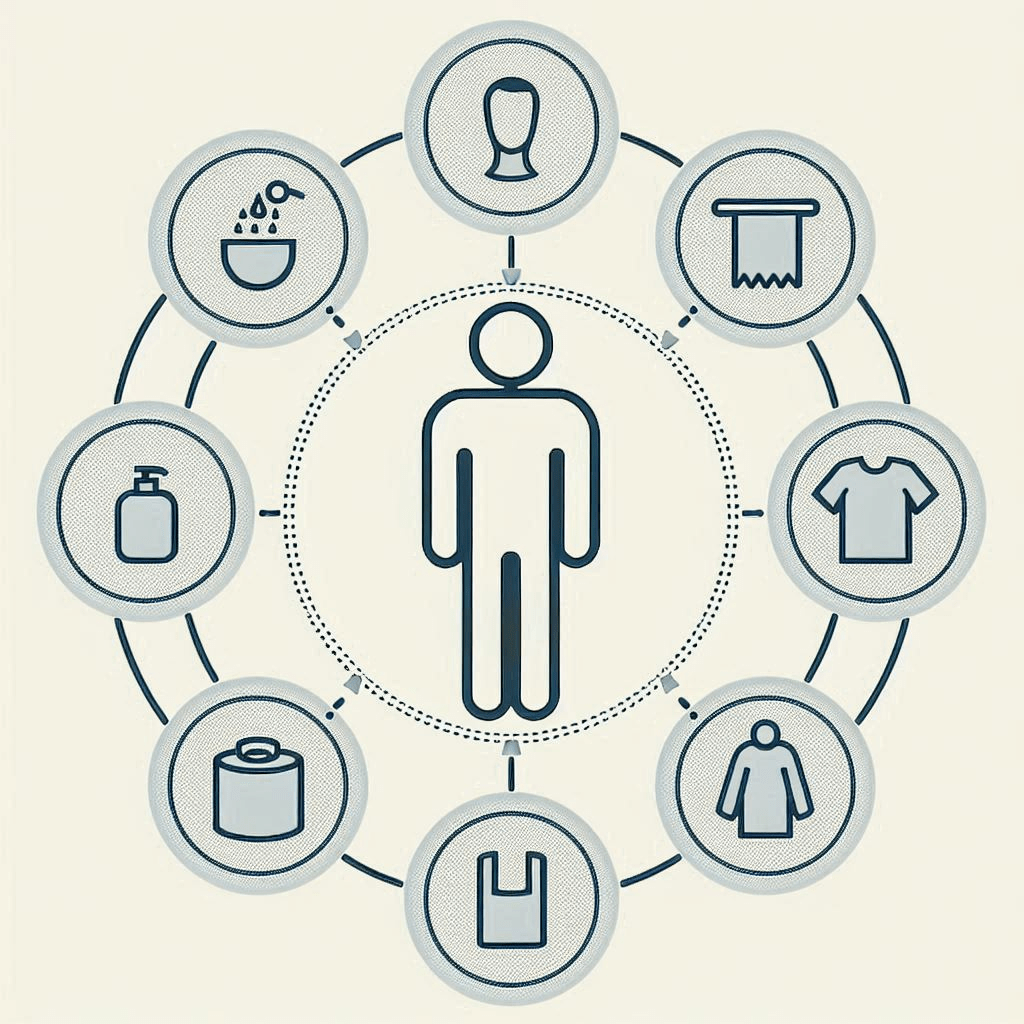
Activities of Daily Living (ADL) are basic tasks an individual must complete each day to maintain independence. They are essential for survival and include:
- Personal Care: Bathing, grooming, oral, nail, and hair care.
- Continence Management: The ability to use the bathroom independently.
- Dressing: The ability to select and wear appropriate clothing.
- Feeding:The ability to feed oneself.
- Ambulating: The ability to move from one position to another and to walk independently.
Instrumental Activities of Daily Living (IADL)
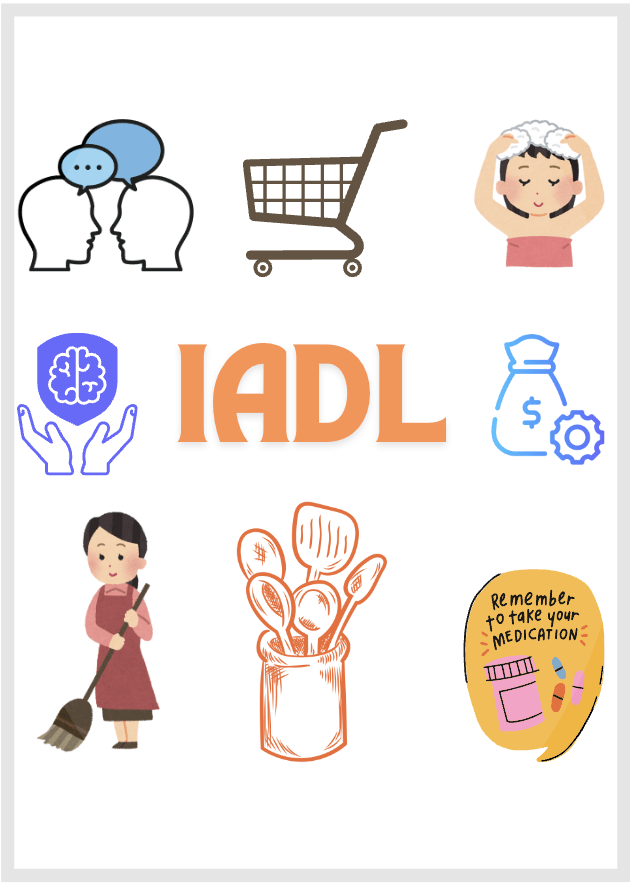
Instrumental Activities of Daily Living (IADL) are more complex tasks necessary for independent living. They are crucial for determining whether an individual can live independently, safely, and securely in the community. They include:
– Managing a Household: Cleaning, removing trash, tidying up, doing laundry, folding clothes.
– Managing Medications:The ability to get prescriptions filled, keep medications up to date, and take medication as prescribed (correct time and dose).
– Communication: The ability to manage phone calls, mail, and welcome visitors.
– Managing Finances: The ability to manage bank accounts, pay bills on time, and balance checkbooks.
– Companionship and Mental Support: Essential for maintaining a positive frame of mind.
– Transportation and Shopping: The ability to independently get groceries and pharmacy items.
– Preparing Meals: The ability to plan and prepare meals, including shopping and putting away groceries.
Enhancing Remaining Vision
Despite these challenges, most people with low vision can improve their remaining vision with appropriate care and techniques and adaptive tools. Enhancements such as better lighting, the use of bright contrasting colors, and specialized products like magnifiers and talking devices can significantly aid daily functioning and support independence.
For instance, task lighting can be strategically placed to illuminate work areas, adding some ambient lighting to improve general lighting in home or workplace, making activities like reading and cooking easier. High-contrast colors can be used to differentiate between objects and surfaces, reducing the risk of accidents.
Magnifiers, both Optical and electronic, can make reading small print more accessible. Talking devices, such as clocks, watches, kitchen scales, Calculator, and etc, can provide essential information audibly, reducing the reliance on visual input.
Emotional and Psychological Support
Addressing the emotional and psychological impact of low vision is crucial. Losing vision can be a daunting experience, often leading to feelings of vulnerability and loss of independence.
Counseling and support groups provide a safe space to express these feelings and develop coping strategies. Rehabilitation services offer training on how to perform daily tasks safely and effectively, boosting confidence and self-sufficiency.

Coping with Vision Loss
When experiencing vision loss, individuals go through stages of coping, which involves using thoughts and actions to handle challenging situations. Coping is essential when the situation feels overwhelming and resources seem insufficient.
Personal Factors Influencing Coping
Several personal factors influence how well someone copes with vision loss:
– Personality: Motivation and a sense of humor can significantly aid in coping.
– Resilience: Previous experiences with adaptation and coping play a role.
– Attitudes: Former attitudes about impairment or disability affect coping mechanisms.
– Intelligence: Problem-solving skills and understanding of the situation are crucial.
– Education: Those with higher education levels tend to adapt better (Tolman et al., 2005).
– Gender: Men report adapting better than women (Tolman et al., 2005).
– Age at Onset: Younger individuals adapt better than older ones (Lindo & Nordholm, 1999; Tolman et al., 2005).
– Severity of Vision Impairment: Interestingly, those who lose their vision completely often adapt better than those with usable residual vision.
– Stability of Vision Impairment: Stability and consistency in the level of impairment can affect adaptation.
– Time Since Vision Loss: Adaptation takes time (Jangra et al., 2007).
– Co-morbidities: Other existing health conditions can impact the adaptation process.
– Philosophy of Life and Beliefs: Personal beliefs and life philosophy play a significant role in coping.
External Factors Influencing Coping
External factors also significantly influence how well someone copes with vision loss:
– Role of the Ophthalmologist: Support and guidance from eye care professionals are essential.
– Social Network: Family, friends, and social connections provide emotional and practical support.
– Professional Resources and Services: Access to rehabilitation services, counselors, and support groups is crucial.
– Role Models: Positive role models who have successfully adapted to vision loss can provide inspiration and practical advice.
– Employment: Engagement in meaningful work or activities can boost self-esteem and provide a sense of purpose.
Additional Support Strategies
– Counseling and Therapy: Professional counseling can help address emotional and psychological challenges.
– Support Groups: Joining support groups allows individuals to share experiences and learn from others facing similar challenges. There are services available in Canada in Canadian Institution for the Blind (CNIB) named Peer support services.
– Adaptive Skills Training: Rehabilitation services teach practical skills for daily living, enhancing independence.
– Assistive Technology: Tools like screen readers, magnifiers, and voice-activated devices can aid in daily tasks.
– Community Resources: Local organizations often provide resources and support for individuals with low vision.
Professional Assistance
Certified Low vision specialists (CLVT), Occupational Therapists (OT), Certified Orientation and Mobility Specialist (COMS), Certified Vision Rehabiliation Therapist, can offer tailored advice and training. These professionals can help create a personalized plan to maximize remaining vision and improve quality of life. They can also recommend appropriate assistive devices and technologies based on individual needs.
Maintaining an Active Lifestyle
Despite the limitations imposed by low vision, it is possible to maintain an active and fulfilling lifestyle. Engaging in hobbies, physical activities, and social interactions can enhance overall well-being. Adaptations and assistive devices can make many activities accessible. For example, large-print books and audiobooks allow individuals to continue enjoying reading. Adaptive sports programs offer opportunities for physical exercise and social engagement.
1. Start Small:
It is common to feel overwhelmed when first attempting to make your home safer and more functional. Begin with an area you use the most. For instance, if you have trouble reading, start with your favorite reading chair. Replace a small table lamp with a floor lamp that has a flexible neck, providing better lighting for reading.
2. Create Clear Walkways:
Since low vision increases fall risk, ensure you have clear walking paths at least three feet wide through each room. Make sure there are no holes, rips in the carpet, or other floor irregularities.
3. Use Bright Contrasting Colors:
Enhance your ability to see important objects or areas by using bright contrasting colors throughout your home. Outline the edges of steps, coffee tables, doorways, and bathtubs with colored plumber’s tape. For example, use bright red or white against dark wooden steps or dark blue against a white wall.
4. Incorporate Various Textures:
Use textures like Velcro, rubber bands, and raised dots to provide tactile clues. Apply these to the on/off controls on appliances, at the end of banisters, or on medicine bottles to help with identification and orientation.
5. Increase General Lighting:
Use Floor lamp and several lamps to light a room evenly and ensure that lighting is adequate at night. Proper lighting can reduce shadows and improve visibility.
6. Enhance Task Lighting:
Use a Lamp with a flexible neck so you can direct the light exactly where you need it. This is especially helpful for activities like reading, cooking, or doing hobbies.
7. Control Glare:
Minimize glare by covering windows with blinds or drapes, using shades on all lamps, and choosing matte finishes for furniture and floors. Glare can make it harder to see and cause discomfort.
Reducing glare can significantly improve visual comfort and clarity, making it easier to go about daily activities without strain. For those who spend a lot of time indoors, it’s essential to consider the impact of lighting on eye health.
Wearing fit-over filters can also be a big help to people whose eyes are sensitive to light. These filters fit over regular glasses and provide an extra layer of protection against harsh light.
If your eyes are sensitive to indoor light, such as ceiling lights at home, the workplace, grocery stores, and similar places, or when you want to go out at night, Yellow fit-over lenses are the best option for many people.
This filter, also known as computer glasses or night driving glasses, helps reduce glare and improve visual comfort in various settings. These glasses are especially beneficial for those who experience discomfort under fluorescent lights commonly found in office spaces and public buildings.
Additionally, Grey or Amber colour filters are the best choices for a sunny or snowy day when it is too bright.
These filters help to reduce the intense brightness and glare that can occur on clear days or in reflective conditions, such as when sunlight reflects off snow or water.
By wearing these filters, you can protect your eyes from excessive light and reduce the risk of eye strain or damage.
On the other hand, Plum colour filters are great for outdoor use when it is not too bright or when going outside in the afternoon or early morning. These filters enhance contrast and improve visual clarity in lower light conditions, making them ideal for activities such as walking, or gardening during the cooler parts of the day.
8. Use Large Print:
Ask your pharmacist to provide large print labels on your medicine bottles. Make on/off labels in large black print on a white background for appliances. Choose large-print cookbooks, playing cards, and newspapers to make reading easier.
9. Consult a Vision Loss Rehab Provider:
Check with your vision loss rehabilitation provider for information on visual aids and magnification tools. They can offer personalized advice and recommend the best products for your needs.
10. Utilize This Guide:
Obtain more information and practical tips by using this guide. It offers a wealth of strategies to help you manage daily tasks more effectively and maintain your independence.
Additional Tips for Living with Low Vision
– Organize Your Space: Keep your home well-organized and clutter-free. Knowing exactly where items are located can save time and reduce frustration.
– Labeling: Use large, bold labels on drawers, cupboards, and storage containers. Label items in a consistent manner to make finding things easier. There are available labels to mark appliances and make them more visible
– Technology: Explore technology options such as voice-activated assistants (like Amazon Alexa or Google Assistant) to help with tasks like setting reminders, making phone calls, and controlling smart home devices.
– Regular Eye Exams: Continue regular eye exams with your ophthalmologist to monitor any changes in your vision and adjust your care plan accordingly.
– Exercise: Engage in regular physical activity to maintain overall health and mobility. Adaptive exercise programs designed for people with low vision can be a great way to stay active.
– Social Support: Connect with others who have low vision through support groups or online communities. Sharing experiences and tips can provide emotional support and practical advice.
– Professional Services: Utilize services from low vision specialists, occupational therapists, and mobility instructors to receive tailored assistance and training.
By following these steps and utilizing available resources, individuals with low vision can improve their daily living experience, enhance their safety, and maintain their independence.
Available resources and supports in Canada:
There are two organizations in Canada that provide support and assistance for people with vision impairment and blindness: CNIB and VLRC.
What is CNIB?
The Canadian National Institute for the Blind (CNIB) is a key organization in Canada that supports individuals with vision loss. CNIB offers a wide range of programs and services aimed at improving the lives of those who are blind or partially sighted. Their mission is to empower people with vision impairment to live full, independent lives.

CNIB provides various services, including vision rehabilitation, assistive technology training, and programs that enhance mobility and daily living skills. They also offer resources for employment support, advocacy, and community engagement, helping individuals overcome the barriers that vision loss can present.
In addition to practical assistance, CNIB focuses on fostering a sense of community and belonging among people with vision loss. They offer peer support groups, recreational activities, and opportunities for social interaction, helping individuals connect with others who share similar experiences. Through their work, CNIB strives to create an inclusive society where people with vision loss can fully participate and thrive.
What is VLRC?
Vision Loss Rehabilitation Canada (VLRC) is a premier organization in Canada dedicated to offering specialized services for individuals experiencing vision loss. VLRC provides a diverse array of rehabilitation programs designed to empower those with vision impairment or blindness to achieve greater independence and enhance their overall well-being.
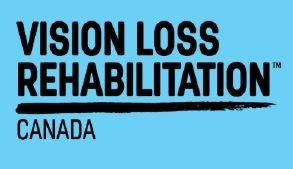
VLRC’s services are customized to fit the specific needs of each person, offering assistance in areas such as mobility training, low vision evaluations, and the use of adaptive technology. They also support daily living skills, enabling individuals to manage everyday tasks more effectively. Whether someone is newly affected by vision loss or has been living with it for years, VLRC provides tailored support to help them adapt and thrive.
Beyond practical rehabilitation, VLRC offers emotional and social resources, guiding individuals and their families through the emotional challenges of vision loss. By focusing on independence and accessibility, VLRC plays a vital role in helping those with vision loss lead active and meaningful lives.
At the end, If you are looking for the best magnifying glass for people with vision impairment read this post.

